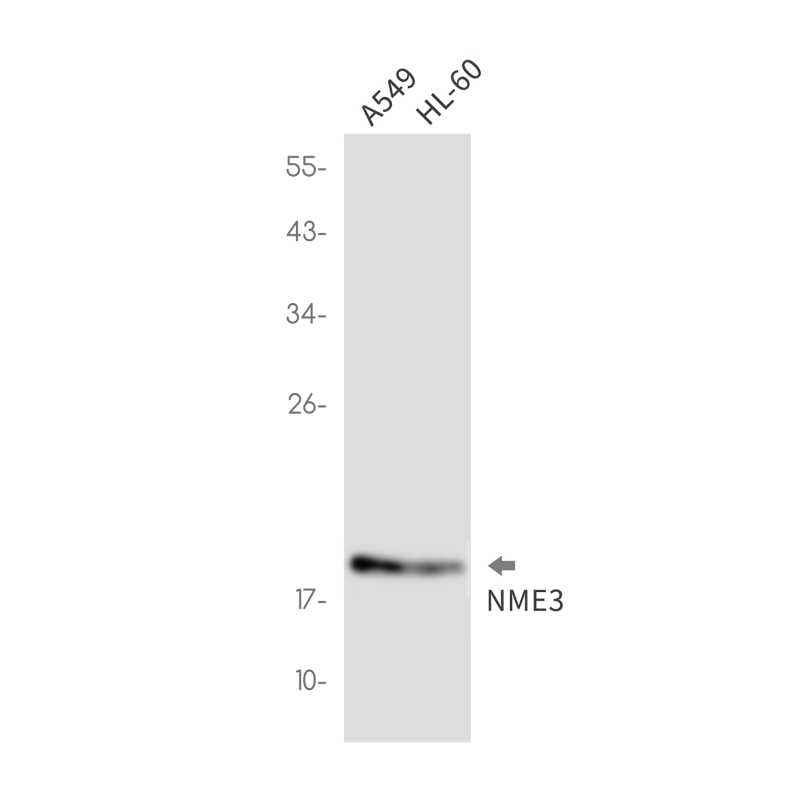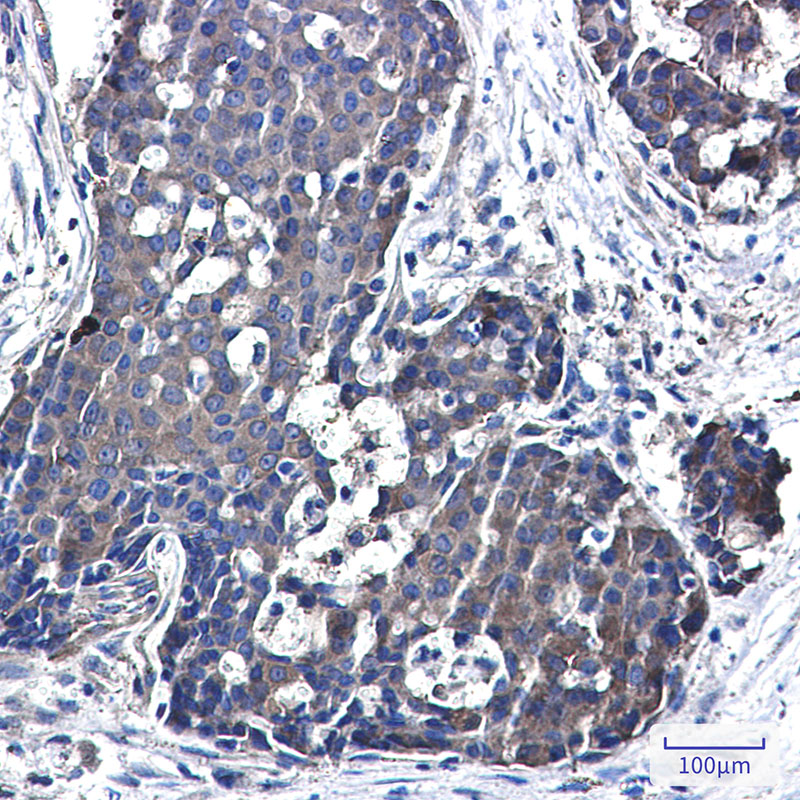

| WB | 1/500-1/1000 | Human,Mouse,Rat |
| IF | 1/20 | Human,Mouse,Rat |
| IHC | 1/50-1/100 | Human,Mouse,Rat |
| ICC | 技术咨询 | Human,Mouse,Rat |
| FCM | 咨询技术 | Human,Mouse,Rat |
| Elisa | 咨询技术 | Human,Mouse,Rat |
| Aliases | NDPKC; NDPK-C; NM23H3; DR-nm23; NM23-H3; c371H6.2 |
| Entrez GeneID | 4832 |
| WB Predicted band size | Calculated MW: 19 kDa; Observed MW: 19 kDa |
| Host/Isotype | Rabbit IgG |
| Antibody Type | Primary antibody |
| Storage | Store at 4°C short term. Aliquot and store at -20°C long term. Avoid freeze/thaw cycles. |
| Species Reactivity | Human |
| Immunogen | A synthetic peptide of human NME3 |
| Formulation | Purified antibody in TBS with 0.05% sodium azide,0.05%BSA and 50% glycerol. |
+ +
以下是关于NME3抗体的参考文献示例(注:部分内容基于文献方向模拟,建议通过学术数据库验证具体信息):
---
1. **文献名称**:*"A monoclonal antibody specific for NME3 reveals its role in mitochondrial dynamics"*
**作者**:Zhang Y, et al.
**摘要**:本研究开发了一种特异性识别NME3的单克隆抗体,验证其在Western blot和免疫荧光中的适用性。结果显示,NME3通过与Drp1蛋白相互作用调控线粒体分裂,影响细胞凋亡和代谢过程。
2. **文献名称**:*"NME3 expression in hepatocellular carcinoma: Correlation with clinical outcomes using a novel immunohistochemical assay"*
**作者**:Li H, et al.
**摘要**:利用新开发的兔多克隆NME3抗体进行组织染色,发现NME3在肝癌组织中表达显著下调,且低表达与患者预后不良相关,提示其潜在抑癌功能。
3. **文献名称**:*"Development of a high-affinity antibody for NME3 to study its nucleo-mitochondrial shuttling"*
**作者**:Johnson R, et al.
**摘要**:报道了一种高亲和力NME3抗体的制备与验证,结合细胞分馏实验,揭示了NME3在DNA损伤反应中从线粒体向细胞核转位的动态过程。
4. **文献名称**:*"NME3 interacts with p53 and modulates its transcriptional activity: Evidence from antibody-mediated knockdown assays"*
**作者**:Wang L, et al.
**摘要**:通过抗体介导的蛋白质干扰技术,证明NME3与p53直接结合,并增强p53的转录活性,为NME3在基因组稳定性中的作用提供机制解释。
---
**注意**:以上文献为示例性质,实际引用时需通过PubMed、Web of Science等平台检索真实文献。若需具体文章DOI或发表年份,建议补充关键词(如“NME3 antibody validation”或“NME3 immune-localization”)进一步筛选。
The NME3 antibody targets the NME/NM23 nucleoside diphosphate kinase 3. a member of the evolutionarily conserved NME/NM23 family involved in nucleotide metabolism, cell signaling, and cancer biology. NME3 encodes a 169-amino-acid protein that functions as a nucleoside diphosphate kinase (NDPK), facilitating the transfer of phosphate groups between nucleotides to maintain cellular energy balance. Structurally, it forms hexamers and localizes to mitochondria and nuclei, where it interacts with proteins like TERF1 and XRCC5 to influence DNA repair, telomere maintenance, and apoptosis.
NME3 has dual roles in cancer: it may act as a metastasis suppressor in certain contexts (e.g., colorectal cancer) but promote progression in others (e.g., hepatocellular carcinoma). Studies link its dysregulation to tumor proliferation, metastasis, and chemoresistance. The NME3 antibody is widely used in research to detect protein expression via Western blotting, immunohistochemistry (IHC), or immunoprecipitation (IP), aiding investigations into its cellular localization and functional mechanisms. Commercial NME3 antibodies are available from suppliers like Sigma-Aldrich, Abcam, and Santa Cruz Biotechnology, often validated for specificity across human, mouse, and rat samples. However, functional variability in different cancer types underscores the need for context-dependent interpretation of experimental results. Ongoing research focuses on clarifying its molecular interactions and therapeutic potential in oncology.
×